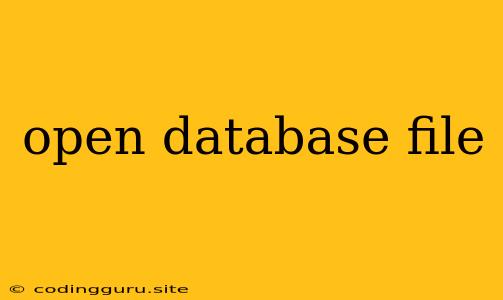How to Open Database Files: A Comprehensive Guide
Working with databases is a fundamental part of many software development projects. A database file stores structured information, and understanding how to open and access this information is crucial for developers and data analysts.
But what exactly is a database file? It's a file containing structured data organized in a specific format, often referred to as a database management system (DBMS). This format allows for efficient storage, retrieval, and manipulation of information.
What are the most common database file formats? There are numerous formats, each suited for different applications and purposes. Some of the most prevalent ones include:
- .db (SQLite): This is a compact and self-contained database file often used in mobile apps, embedded systems, and applications requiring lightweight data storage.
- .accdb (Microsoft Access): A popular choice for creating simple desktop databases, this format is widely used for managing data within organizations.
- .mdb (Microsoft Access): An older version of the Access database file format, still in use for legacy applications.
- .sql (SQL Server): This format is used for storing and retrieving data in a relational database management system (RDBMS).
- .csv (Comma Separated Values): Although not a traditional database file, CSV files are commonly used to export and import data from various databases and applications.
How do you open a database file? The approach to opening a database file depends on its format and the intended purpose. Here are some common methods:
1. Using a Database Management System (DBMS):
- For .db (SQLite) files: You can use tools like SQLite Browser or DB Browser for SQLite to open and view the data. These tools provide a user-friendly interface to navigate tables, query data, and even make modifications.
- For .accdb (Microsoft Access) files: You can use Microsoft Access itself to open and manage these files. Access offers a visual interface for creating tables, relationships, and queries, enabling you to work with the data directly.
- For .mdb (Microsoft Access) files: If you have an older Access version, you can use it to open these files. If you need to work with older versions, you might consider using tools like MDB Viewer or MDB Tools.
- For .sql (SQL Server) files: You can use Microsoft SQL Server Management Studio (SSMS) to connect to SQL Server databases and manage the data.
2. Using a Text Editor:
- For .csv (Comma Separated Values) files: Simple text editors like Notepad (Windows) or TextEdit (Mac) are sufficient to view and edit the data within a CSV file.
3. Using Specific Software:
- For certain specialized database formats, you might need to use dedicated software. For example, MySQL Workbench can be used to open and work with MySQL databases.
Let's look at some specific examples:
Example 1: Opening a SQLite database file:
- Download and install a suitable tool like SQLite Browser or DB Browser for SQLite.
- Launch the tool and navigate to the "Open Database" option.
- Select the .db file you want to open.
- The tool will display the tables, columns, and data within the database.
Example 2: Opening a Microsoft Access database file:
- Open Microsoft Access.
- Click on the "File" menu and select "Open."
- Browse to the location of your .accdb file and select it.
- The database will open, allowing you to view and manage the tables and data.
Best Practices for Opening Database Files:
- Ensure you have the appropriate software: Use the right tools for the specific database file format.
- Back up your database: Before making any changes, create a backup of your original database file to avoid data loss.
- Be careful with modifications: If you are not familiar with database management, proceed with caution when making changes to the data.
- Understand data security: Be mindful of security considerations, especially when working with sensitive data.
How to Open Encrypted Database Files:
Encrypted database files offer an extra layer of security, preventing unauthorized access to the data. To open these files, you usually need the decryption key or password.
- For SQL Server databases: You can use the
ALTER DATABASEcommand to encrypt or decrypt a database. - For other formats: The specific process for opening an encrypted database depends on the chosen encryption method and the tool used.
Tips for Handling Large Database Files:
- Optimize your system: Ensure you have sufficient RAM and processing power for efficient data handling.
- Use specialized tools: Utilize software designed for handling large databases, like SQL Server Management Studio, for optimal performance.
- Optimize your database design: A well-structured database can significantly improve the performance of large data sets.
In Summary:
Opening and working with database files is essential for many tasks related to data management and analysis. By understanding the different formats, tools, and best practices, you can confidently access and utilize the valuable information stored within these files. Remember to prioritize data security and back up your data regularly to ensure its integrity and availability.
